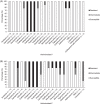Feline mycobacterial disease in northern California: Epidemiology, clinical features, and antimicrobial susceptibility
- PMID: 33346952
- PMCID: PMC7848370
- DOI: 10.1111/jvim.16013
Feline mycobacterial disease in northern California: Epidemiology, clinical features, and antimicrobial susceptibility
Abstract
Background: Mycobacterial infections in cats are challenging to treat and incompletely described.
Hypothesis/objectives: To describe the features of mycobacterial infections in cats from northern California.
Animals: Nineteen cats, all with nontuberculous mycobacterial (NTM) infections; 4 with Mycobacterium avium infection, 15 with rapid-growing mycobacterial (RGM) infection.
Methods: Retrospective study. Cases with positive mycobacterial culture, species identification, and susceptibility testing were included. Descriptive statistics were used. Fisher's exact test and Mann-Whitney U test were used for comparisons between M avium and RGM infections (P ≤ .05).
Results: Rapid-growing mycobacterial cases included Mycobacterium smegmatis (9), Mycobacterium fortuitum (4), Mycobacterium abscessus (1), and Mycobacterium thermoresistibile (1). Mycobacterium avium infections were more likely than RGM infections to be disseminated (3/4 vs 0/15; P = .004). Disease of the skin/subcutis (15/15 vs 0/4; P < .001) and outdoor access (14/15 vs 0/4; P = .001) were primary features of RGM infections. Resistance to fluoroquinolones and aminoglycosides was common among M avium isolates. A high prevalence of resistance to third- and fourth-generation cephalosporins was noted in RGM species. Death/euthanasia was noted only in M avium cases (3/4). Twelve of 15 cats with RGM infection had available follow-up; 4 of these cats achieved remission.
Conclusions and clinical importance: The most prevalent RGM species isolated from cats from northern California are M smegmatis and M fortuitum. Susceptibility to prescribed antimicrobials does not appear to guarantee treatment success. Combination drug treatment is recommended. Repeat culture and susceptibility testing should be performed when disease is persistent/relapsing.
Keywords: antimicrobial; atypical bacteria; cutaneous; panniculitis; systemic; treatment.
© 2020 The Authors. Journal of Veterinary Internal Medicine published by Wiley Periodicals LLC. on behalf of the American College of Veterinary Internal Medicine.
Conflict of interest statement
Authors declare no conflict of interest.
Figures


Similar articles
-
Infection of the subcutis and skin of cats with rapidly growing mycobacteria: a review of microbiological and clinical findings.J Feline Med Surg. 2000 Mar;2(1):35-48. doi: 10.1053/jfms.2000.0051. J Feline Med Surg. 2000. PMID: 11716590 Free PMC article. Review.
-
Mycobacterium setense isolated from a cat with atypical mycobacterial panniculitis.Tierarztl Prax Ausg K Kleintiere Heimtiere. 2021 Oct;49(5):390-396. doi: 10.1055/a-1528-1763. Epub 2021 Jun 24. Tierarztl Prax Ausg K Kleintiere Heimtiere. 2021. PMID: 34169497 English.
-
In Vitro Susceptibility Testing of Omadacycline against Nontuberculous Mycobacteria.Antimicrob Agents Chemother. 2021 Feb 17;65(3):e01947-20. doi: 10.1128/AAC.01947-20. Print 2021 Feb 17. Antimicrob Agents Chemother. 2021. PMID: 33288634 Free PMC article.
-
In vitro interaction of some drug combinations to inhibit rapidly growing mycobacteria isolates from cats and dogs and these isolates' susceptibility to cefovecin and clofazimine.Aust Vet J. 2015 Jan-Feb;93(1-2):40-5. doi: 10.1111/avj.12279. Aust Vet J. 2015. PMID: 25622709
-
An overview of pulmonary infections due to rapidly growing mycobacteria in South Asia and impressions from a subtropical region.Int J Mycobacteriol. 2020 Jan-Mar;9(1):62-70. doi: 10.4103/ijmy.ijmy_179_19. Int J Mycobacteriol. 2020. PMID: 32474491 Review.
Cited by
-
Atypical presentation of disseminated mycobacteriosis due to Mycobacterium avium in an aged cat.Aust Vet J. 2025 Mar;103(3):121-126. doi: 10.1111/avj.13410. Epub 2024 Dec 22. Aust Vet J. 2025. PMID: 39710507 Free PMC article.
-
First report of Mycobacteria avium complex (Mycobacteria intracellulare) in a cat from Southeast Asia.JFMS Open Rep. 2023 Oct 5;9(2):20551169231194311. doi: 10.1177/20551169231194311. eCollection 2023 Jul-Dec. JFMS Open Rep. 2023. PMID: 37810578 Free PMC article.
-
Genomics Insights into Mycolicibacterium Hassiacum Causing Infection in a Cat with Pyogranulomatous Dermatitis and Panniculitis.Pathogens. 2024 Sep 11;13(9):785. doi: 10.3390/pathogens13090785. Pathogens. 2024. PMID: 39338976 Free PMC article.
-
Mycobacterium fortuitum Infection Associated With Septic Arthritis and Mycobacteremia in a Dog From Northern California.J Vet Intern Med. 2025 May-Jun;39(3):e70083. doi: 10.1111/jvim.70083. J Vet Intern Med. 2025. PMID: 40298580 Free PMC article.
-
Case Report: Mycobacterial epidural pyogranulomatous steatitis in a cat.Front Vet Sci. 2025 Jun 4;12:1610313. doi: 10.3389/fvets.2025.1610313. eCollection 2025. Front Vet Sci. 2025. PMID: 40534782 Free PMC article.
References
-
- LoBue PA, Enarson DA, Thoen CO. Tuberculosis in humans and animals: an overview. Int J Tuberc Lung Dis. 2010;14:1075‐1078. - PubMed
-
- Gunn‐Moore DA. Feline mycobacterial infections. Vet J. 2014;201:230‐238. - PubMed
-
- Gunn‐Moore DA, Jenkins PA, Lucke VM. Feline tuberculosis: a literature review and discussion of 19 causes by an unusual mycobacterial variant. Vet Rec. 1996;138:53‐58. - PubMed
-
- Delahay RJ, Smith GC, Barlow AM, et al. Bovine tuberculosis infection in wild animals in the south‐west region of England: a survey of prevalence and semi‐quantitative assessment of the relative risks to cattle. Vet J. 2007;173:287‐301. - PubMed
MeSH terms
Supplementary concepts
LinkOut - more resources
Full Text Sources
Medical
Miscellaneous

